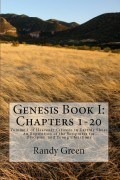Uncovering Secrets in the Bible – Part 1
NEWS FLASH!!! Matthew: Volume 7 of Heavenly Citizens in Earthly Shoes is now available from CreateSpace (paperbacks) and Kindle (eBooks). Click on the link to the right of this page to go to Amazon and place your order.
Yet for us there is but one God, the Father, from whom are all things and we exist for Him; and one Lord, Jesus Christ, by whom are all things, and we exist through Him [1 Corinthians 8:6].
1 Corinthians is in the New Testament, which means it was originally written in koine Greek. The word koine is Greek for “common”, meaning that it wasn’t the flowery Greek of cultured society, or the educated Greek of the Greek philosophers. It was the Greek spoken by the common man on the street of that time.
Even though we’re dealing with the Greek language in the New Testament, nonetheless we are also dealing with the Hebrew people. This means that, though they were speaking another language, they still spoke as Jews and not as Gentiles. With this in mind we shouldn’t be taken aback when we realize they often expressed themselves in terms of parallelism.
Parallelism is the style used in Biblical Hebrew poetry. We today rhyme words at the end of lines and call it poetry. The Hebrews rhymed ideas within the lines and called that poetry. The ideas might roughly coincide with each other, or they might be opposites of each other. Poetry which expresses coinciding ideas is known as synonymous parallelism. Poetry which expresses opposite ideas is known as antonymous parallelism.
Even when they presented narrative instead of poetry, it was not unusual by any means to find parallelism in the writing. When we today use alliteration in our narrative writing, we are employing a concept from poetry. And this is what we have in our Bible verse which kicked off our study today. Let’s consider it in that light now.
The parallelism is between the Father and the Son, and it is synonymous. The Father is identified as “God”, while the Son (i.e., “Jesus Christ”) is identified as “Lord”. But what follows from this is where the parallelism really comes into play. Permit me to express it as a numbered list.
from whom are all things and we exist for Him (i.e., the Father)
by whom are all things, and we exist through Him (i.e., the Son)
It should be ostensible to you, the way the two phrases run “parallel” with each other. But lest perchance anyone miss out on the fine details, I will spell them out to you. Again, a numbered list suits our purposes and shortens the explanation needed.
from whom are all things parallels by whom are all things
we exist for Him parallels we exist through Him
Now mull over the difference between the words “from” and “by”. They express the only difference in Line #1 of the preceding list. Both words are prepositions. So, then, what difference is portrayed by them in these two prepositional phrases? Answer: the phrase from whom are all things emphasizes the Father as the originator of all things. The phrase by whom are all things tells us that the Father created all things by means of His Son.
Do you see why I identified this as synonymous parallelism and not antonymous? The two ideas parallel each other in an agreeable fashion. They pull together rather than push apart. We learn that God is the Creator. He created as both the Father and the Son, and the two Persons worked together in perfect harmony, as One God.
We will decipher Line #2 in our next study. Be sure to be there. It gets even tastier.
To further research this issue, I direct you to my book Genesis: Volume 1 of Heavenly Citizens in Earthly Shoes. To purchase my books please go to:
http://www.amazon.com/Randy-Green/e/B00507WC86
Filed under: Church Age Tagged: 1 Corinthians 8, God the Father, God the Son, Hebrew poetry, Son of God, Trinity






